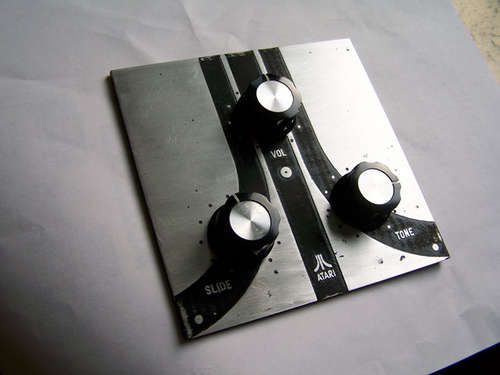This clever Instructable demonstrates how to etch beautiful aluminum control panels for electronics projects. We like how similar this process is to DIY circuit board etching. Both abide by the same technique and use blue transfer paper. The primary difference is in the use of muriatic acid and hydrogen peroxide for etching aluminum.
Month: August 2009
Xbox Crammed Into Inch-thick Package

Reminiscent of [Ben Heck]’s portable and laptop console mods, [Bandit5317] over at Xbox-Scene managed to fit the guts of an original Xbox into a custom-built slim case that measures just 2.5 centimeters thick. In his post, he describes some of the difficulties of cutting down a behemoth Xbox to a third of its original size, such as rewiring a custom IDE cable to avoid the extra 1/16-inch it would take to fold a standard one. The case is hand-crafted, (no laser cutter!) no-frills box made of painted polycarbonate, and man is it sexy. It is built off of a v1.4 motherboard running a third-party BIOS and with a 320GB laptop hard drive. Load up XBMC Media Center and you’ve got the slimmest home theater PC on the block.
[thanks FranklyCrafty]
Rename Files En Masse In Windows

Everybody hates it when they have to rename a fileset to fit a new naming scheme. Instead of doing it the hard way and writing a one-time script to go through and rename everything, check out Bulk Rename Utility from [Jim Willsher]. It provides you with a multitude of methods to take care of business and allows you do pick your favorite method, be it regular expressions, simple finding and replacing, prefix/suffix modification, or a combination of many more.
However, if the sheer amount of options available overwhelms you or if you just want an easier way to do things, check out A.F.5 from [Alex Fauland]. A.F.5 offers features like adding a counter to your filenames, change file attributes, and save your rename settings out to a file for repeat use.
Quick And Dirty Magnetic Card Reader

[nevdull] found himself in possession of a magnetic card reader. What else was he to do but show us all how to read from it using an AVR? He goes through the basics of how the card reader works, as well as how to detect the different card states such as entering, reading, leaving. There is source code to download to try for yourself, but unless you have the same reader, you’ll have to do some modifications. While this doesn’t get you all the way to reading the complete content off of the card, its a great start. Maybe you guys can help him finish up the last bits.
Moon Phase Light Modification
[youtube=http://www.youtube.com/watch?v=F0yKRRh9LF0]
In this project, a moon phase light is modified to show the actual moon phase based off of your computer’s internal clock. From the factory, these moon lights are updated via an infra red remote control. He pulled the brains from the clock and replaced them with an Arduino. He then runs a program that updates the Arduino based off of the system clock. He has also added an internal clock to maintain the settings so constant updates are not required. It would have been nice to retain manual functions via the remote so you could press a button for a full moon without having to change your system time.
[via littlebirdceo]
Kegbot

The folks at Revision3 really know what gets our pulse going. In this episode, they show us how they built a radio controlled keg. Not only is the system built sturdy enough to cart around the keg, it is also built with the capability for the driver to control the beer flow. This isn’t too shabby for a pretty quick project, but it still can’t compare with Bar2D2.
Cheap SD Card Cradle

When utilizing an SD card in your projects, you would generally buy an SD card slot to wire in. Sometimes, you just don’t plan that far ahead, or maybe you just want to play with an SD a little bit to see what you think. [Kroden] shows us how to make a fairly simple and cheap SD card dock. The result is actually pretty impressive looking. He has simply bent some header pins and soldered them together to make a simple SD slot. It can even be adapted to a horizontal layout for more permanent use.











